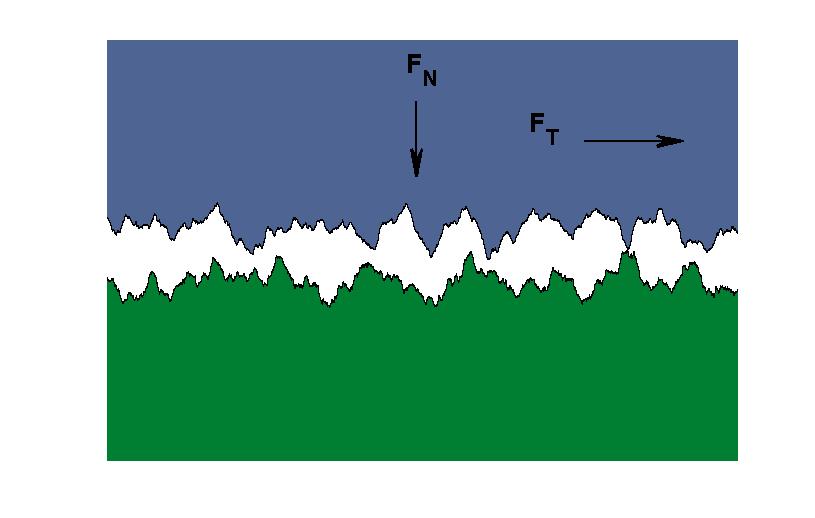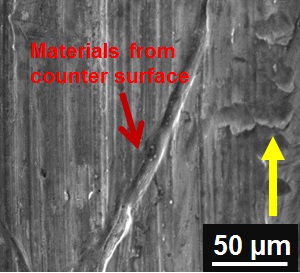|
Asperity (materials Science)
In materials science, asperity, defined as "unevenness of surface, roughness, ruggedness" (from the Latin ''asper''—"rough"), has implications (for example) in physics and seismology. Smooth surfaces, even those polished to a mirror finish, are not truly smooth on a microscopic scale. They are rough, with sharp, rough, or rugged projections, termed "asperities". Surface asperities exist across multiple scales, often in a self-affine or fractal geometry. The fractal dimension of these structures has been correlated with the contact mechanics exhibited at an interface in terms of friction and contact stiffness. An understanding of the concept of asperities is required for any understanding of the field of Tribology, or the scientific study of friction, wear, and lubrication. Expanding on the linkage between asperities and seismology, asperities are critical in the understanding of geophysical faults via elastic deformation. These faults, such as the San Andreas fault line, te ... [...More Info...] [...Related Items...] OR: [Wikipedia] [Google] [Baidu] |
Normal Contact Stiffness
Normal contact stiffness is a physical quantity related to the generalized force displacement behavior of rough surfaces in contact with a rigid body or a second similar rough surface. Specifically it is the amount of force per unit displacement required to compress an elastic object in the contact region. Rough surfaces can be considered as consisting of large numbers of asperities. As two solid bodies of the same material approach one another, the asperities interact, and they transition from conditions of non-contact to homogeneous bulk behaviour, with changes in the contact area. The varying values of stiffness and true contact area at an interface during this transition are dependent on the conditions of applied pressure and are of importance for the study of systems involving the physical interactions of multiple bodies including granular matter, electrode contacts, and thermal contact In heat transfer and thermodynamics, a thermodynamic system A thermodynamic system ... [...More Info...] [...Related Items...] OR: [Wikipedia] [Google] [Baidu] |
Materials Science
Materials science is an interdisciplinary field of researching and discovering materials. Materials engineering is an engineering field of finding uses for materials in other fields and industries. The intellectual origins of materials science stem from the Age of Enlightenment, when researchers began to use analytical thinking from chemistry, physics, and engineering to understand ancient, phenomenological observations in metallurgy and mineralogy. Materials science still incorporates elements of physics, chemistry, and engineering. As such, the field was long considered by academic institutions as a sub-field of these related fields. Beginning in the 1940s, materials science began to be more widely recognized as a specific and distinct field of science and engineering, and major technical universities around the world created dedicated schools for its study. Materials scientists emphasize understanding how the history of a material (''processing'') influences its struc ... [...More Info...] [...Related Items...] OR: [Wikipedia] [Google] [Baidu] |
Burnishing (metal)
Burnishing is the deformation (engineering), plastic deformation of a surface due to friction, sliding contact with another object. It smooths the surface and makes it shinier. Burnishing may occur on any sliding surface if the contact stress locally exceeds the yield (engineering), yield strength of the material. The phenomenon can occur both unintentionally as a failure mode, and intentionally as part of a metalworking or manufacturing process. It is a squeezing operation under cold working. Failure mode (unintentionally) The action of a hardened ball against a softer, flat plate illustrates the process of burnishing. If the ball is pushed directly into the plate, stresses develop in both objects around the area where they contact. As this normal force increases, both the ball and the plate's surfaces deform. The deformation caused by the hardened ball increases with the magnitude of the force pressing against it. If the force on it is small, when the force is released both ... [...More Info...] [...Related Items...] OR: [Wikipedia] [Google] [Baidu] |
Surface Roughness
Surface roughness or simply roughness is the quality of a surface of not being smooth and it is hence linked to human ( haptic) perception of the surface texture. From a mathematical perspective it is related to the spatial variability structure of surfaces, and inherently it is a multiscale property. It has different interpretations and definitions depending on the disciplines considered. In surface metrology, surface roughness is a component of surface finish (surface texture). It is quantified by the deviations in the direction of the normal vector of a real surface from its ideal form. If these deviations are large, the surface is rough; if they are small, the surface is smooth. Roughness is typically assumed to be the high-frequency, short-wavelength component of a measured surface. However, in practice it is often necessary to know both the amplitude and frequency to ensure that a surface is fit for a purpose. Role and effect Roughness plays an important role in determin ... [...More Info...] [...Related Items...] OR: [Wikipedia] [Google] [Baidu] |
Archard Equation
The Archard wear equation is a simple model used to describe sliding wear and is based on the theory of Asperity (materials science), asperity contact. The Archard equation was developed much later than (sometimes also known as energy dissipative hypothesis), though both came to the multiple discovery, same physical conclusions, that the volume of the removed debris due to wear Wear is the damaging, gradual removal or deformation of material at solid surfaces. Causes of wear can be mechanical (e.g., erosion) or chemical (e.g., corrosion). The study of wear and related processes is referred to as tribology. Wear in ... is proportional to the work done by friction forces. Theodor Reye's model became popular in Europe and it is still taught in university courses of applied mechanics. Until recently, Reye's theory of 1860 has, however, been totally ignored in English and American literature where subsequent works by Ragnar Holm and John Frederick Archard are usually cited. In ... [...More Info...] [...Related Items...] OR: [Wikipedia] [Google] [Baidu] |
Wear
Wear is the damaging, gradual removal or deformation of material at solid surfaces. Causes of wear can be mechanical (e.g., erosion) or chemical (e.g., corrosion). The study of wear and related processes is referred to as tribology. Wear in machine elements, together with other processes such as fatigue and creep, causes functional surfaces to degrade, eventually leading to material failure or loss of functionality. Thus, wear has large economic relevance as first outlined in the Jost Report. Abrasive wear alone has been estimated to cost 1–4% of the gross national product of industrialized nations. Wear of metals occurs by plastic displacement of surface and near-surface material and by detachment of particles that form wear debris. The particle size may vary from millimeters to nanometers. This process may occur by contact with other metals, nonmetallic solids, flowing liquids, solid particles or liquid droplets entrained in flowing gasses. The wear rate is affected ... [...More Info...] [...Related Items...] OR: [Wikipedia] [Google] [Baidu] |
Friction
Friction is the force resisting the relative motion of solid surfaces, fluid layers, and material elements sliding against each other. Types of friction include dry, fluid, lubricated, skin, and internal -- an incomplete list. The study of the processes involved is called tribology, and has a history of more than 2000 years. Friction can have dramatic consequences, as illustrated by the use of friction created by rubbing pieces of wood together to start a fire. Another important consequence of many types of friction can be wear, which may lead to performance degradation or damage to components. It is known that frictional energy losses account for about 20% of the total energy expenditure of the world. As briefly discussed later, there are many different contributors to the retarding force in friction, ranging from asperity deformation to the generation of charges and changes in local structure. When two bodies in contact move relative to each other, due to these variou ... [...More Info...] [...Related Items...] OR: [Wikipedia] [Google] [Baidu] |
Materials Science
Materials science is an interdisciplinary field of researching and discovering materials. Materials engineering is an engineering field of finding uses for materials in other fields and industries. The intellectual origins of materials science stem from the Age of Enlightenment, when researchers began to use analytical thinking from chemistry, physics, and engineering to understand ancient, phenomenological observations in metallurgy and mineralogy. Materials science still incorporates elements of physics, chemistry, and engineering. As such, the field was long considered by academic institutions as a sub-field of these related fields. Beginning in the 1940s, materials science began to be more widely recognized as a specific and distinct field of science and engineering, and major technical universities around the world created dedicated schools for its study. Materials scientists emphasize understanding how the history of a material (''processing'') influences its struc ... [...More Info...] [...Related Items...] OR: [Wikipedia] [Google] [Baidu] |
Interface (chemistry)
In the physical sciences, an interface is the boundary between two spatial regions occupied by different matter, or by matter in different physical states. The interface between matter and air, or matter and vacuum, is called a surface, and studied in surface science. In thermal equilibrium, the regions in contact are called phases, and the interface is called a phase boundary. An example for an interface out of equilibrium is the grain boundary in polycrystalline matter. The importance of the interface depends on the type of system: the bigger the quotient area/volume, the greater the effect the interface will have. Consequently, interfaces are very important in systems with large interface area-to-volume ratios, such as colloids. Interfaces can be flat or curved. For example, oil droplets in a salad dressing are spherical but the interface between water and air in a glass of water is mostly flat. Surface tension is the physical property which rules interface process ... [...More Info...] [...Related Items...] OR: [Wikipedia] [Google] [Baidu] |
Contact Mechanics
Contact mechanics is the study of the Deformation (mechanics), deformation of solids that touch each other at one or more points. A central distinction in contact mechanics is between Stress (mechanics), stresses acting perpendicular to the contacting bodies' surfaces (known as normal stress) and frictional stresses acting Tangential and normal components, tangentially between the surfaces (shear stress). Normal contact mechanics or frictionless contact mechanics focuses on normal stresses caused by applied normal forces and by the adhesion present on surfaces in close contact, even if they are clean and dry. ''Frictional contact mechanics'' emphasizes the effect of friction forces. Contact mechanics is part of mechanical engineering. The physical and mathematical formulation of the subject is built upon the mechanics of materials and continuum mechanics and focuses on computations involving Elasticity (physics), elastic, viscoelasticity, viscoelastic, and Plastic Deformation, p ... [...More Info...] [...Related Items...] OR: [Wikipedia] [Google] [Baidu] |





